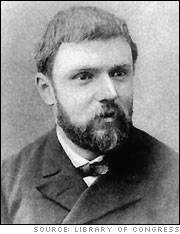The Clay Institute’s Millennium Problems
Birch and Swinnerton-Dyer ConjectureHodge ConjectureNavier-Stokes EquationP vs NP ProblemPoincaré ConjectureRiemann HypothesisYang-Mills and Mass Gap
Related Links
Henri PoincaréBernard RiemanFields Medal WinnersTopologyBiographies of Mathematicians
Million Dollar Reward
To create a bit of frisson among the public for the so-called Millennium Prize Problems, the Clay Institute announced it would offer a one-million-dollar reward apiece for solutions to the problems. While a layperson might have a tough time penetrating the quantum physics behind the Yang-Mills and Mass Gap problem, they have no difficulty understanding the meaning of the number 1 followed by 6 zeros and preceded by a dollar sign.
Poincaré Conjecture—Solved?
Seven years after the Clay Institute announced its challenge, the century-old Poincaré Conjecture, one of the thorniest of the millennium problems, has been solved. Ever since French mathematician Henri Poincaré posed the conjecture in 1904, at least a half-dozen eminent mathematicians—and many lesser ones—have tried and failed to crack the problem. But a series of papers on the conjecture posted online in 2002 and 2003 by Russian Grigory Perelman have successfully withstood intense scrutiny by the mathematical community for the past four years—twice the number of years of public examination required by the Clay Institute.
What Is the Conjecture?
Poincaré’s Conjecture deals with the branch of math called topology, which is the study of shapes, spaces, and surfaces. The Clay Institute offers this deceptively friendly-sounding doughnut-and-apple explication of the bedeviling problem: The resolution of Poincaré’s Conjecture will have enormous implications for our understanding of relativity and the shape of space.
Reclusive Russian
But while mathematicians are hailing this as potentially the biggest breakthrough since Andrew Wiles solved Fermat’s Last Theorem in 1994, Grigory Perelman himself has taken a decidedly standoffish attitude to his accomplishment. He has shown no interest in collecting the million-dollar prize, and instead of publishing his solution in a “refereed mathematics publication of worldwide repute,” as the Clay Institute requires, he simply published his papers online. His proof never even mentions Poincaré by name and is presented in such a sketchy and elliptical fashion that it resembles guidelines for proving the conjecture more than an actual proof. Once having answered the problem to his own satisfaction, one can only speculate, Perelman considered public validation superfluous.
Perelman Unraveled
In the spring and summer of 2006, three groups of mathematicians published papers that fill in the gaps left by Perelman’s unorthodox solution. Mathematicians disagree, however, as to whether any of these papers actually add to solving of the conjecture or simply explicate Perelman’s work. James Carlson, president of the Clay Institute, admits that the existence of Perelman’s almost telegraphic solution (his three papers range in length from 7–39 pp.) and the three lengthy exegeses of his work by other mathematicians (which range in length from 192–329 pp.) is “definitely an unusual situation, but what’s important is that the person who made the breakthrough put it out there so the community could scrutinize and analyze it.”
No-Show for the Fields Medal
On Aug. 22, the International Congress of Mathematicians in Madrid opened with the announcement that Perelman was one of the recipients of the enormously prestigious Fields Medal for his solution to Poincaré’s Conjecture as well as for other significant mathematical contributions. Perelman refused to attend the conference and rejected the award. Serge Rukshin, Perelman’s former teacher, described Perelman as a “devoted scientist in the pure sense of the word. He believes that the most important thing is that the problem is solved.” The Clay Institute has indicated that it may change the requirements for awarding the prize since Perelman has clearly solved it. Perelman hasn’t entirely ruled out the Millennium prize, however, commenting that “I’m not going to decide whether to accept the prize until it is offered.”
More from Math and Money
